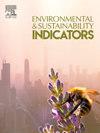Application of a novel vegetation condition index using MODIS EVI for structuring crop index insurance under a smallholder system
IF 5.4
Q1 ENVIRONMENTAL SCIENCES
引用次数: 0
Abstract
Because of the ongoing pressure from climate change, there is a greater need for improved crop index insurance systems, and earth observation technology has made this possible. Accordingly, this study aims to develop a novel crop index insurance scheme using an innovative approach of developing a Vegetation Condition Index derived from Enhanced Vegetation Index (VCI-evi) that potentially addresses the limitations of existing products. This study is placed in a widely known drought-affected district of Ethiopia, the Amhara region. The study took advantage of a 16-day composite of MODIS EVI and a well-archived historical (2007–2022) in-situ data on drought prevalence, which is managed by the R4 crop insurance program, one of the well-established insurance schemes at a global scale. Across the study districts, using the VCI-evi variable, drought is predicted at a confidence interval greater than or equal to 99 %. The proposed approach is applied to establish index insurance parameters, notably, trigger and exit thresholds, as well as payout. Due to the wider prevalence of drought, which is strongly predicted and validated, across all the study villages in the years of 2015, 2016, 2018 and 2011, those years were identified as major drought years. Data on farmers’ bad years ranking was used to validate and revealed a higher level of agreement with model-predicted drought years. Therefore, the approach which is introduced in this study could be used to design an original index insurance scheme in several drought-prone systems offering increased reliability and enhanced scale-up.

基于MODIS EVI的新型植被状况指数在小农作物指数保险构建中的应用
由于气候变化带来的持续压力,更需要改进作物指数保险系统,而地球观测技术使这成为可能。因此,本研究旨在开发一种新的作物指数保险方案,该方案采用一种创新的方法,即从增强植被指数(VCI-evi)中开发植被状况指数,从而潜在地解决现有产品的局限性。这项研究是在埃塞俄比亚一个众所周知的受干旱影响的地区——阿姆哈拉地区进行的。该研究利用了MODIS EVI的16天综合数据和一个保存完好的历史(2007-2022)原位干旱流行率数据,该数据由R4作物保险计划管理,R4作物保险计划是全球范围内成熟的保险计划之一。在整个研究区域,使用VCI-evi变量,预测干旱的置信区间大于或等于99%。所提出的方法被应用于建立指数保险参数,特别是触发和退出阈值,以及支付。由于2015年、2016年、2018年和2011年所有研究村庄的干旱普遍程度更高,这一点得到了强烈的预测和验证,因此这些年份被确定为主要干旱年。农民的干旱年份排名数据被用来验证并揭示了与模型预测的干旱年份更高水平的一致性。因此,本研究中引入的方法可用于在几个干旱易发系统中设计原始指数保险方案,提供更高的可靠性和增强的规模。
本文章由计算机程序翻译,如有差异,请以英文原文为准。
求助全文
约1分钟内获得全文
求助全文
来源期刊

Environmental and Sustainability Indicators
Environmental Science-Environmental Science (miscellaneous)
CiteScore
7.80
自引率
2.30%
发文量
49
审稿时长
57 days
 求助内容:
求助内容: 应助结果提醒方式:
应助结果提醒方式:


